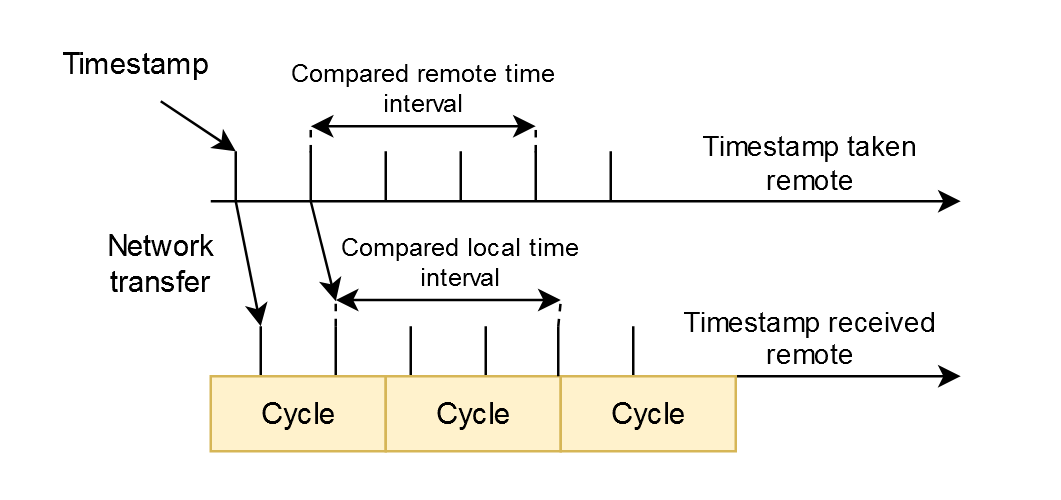Timestamp Exceptions
The following section describes errors which can occur when validating the time behavior of the safe controller. An independent second time base is required to validate the time behavior.
The different timestamps
Three timestamps are used to validate the time behavior of the safe controller.
 |
Remote Timestamp: Timestamp taken from the time provider computer.Sample Timestamp: Timestamp taken locally at the time of receipt.Local Timestamp: Timestamp taken locally at the time the application was run.
Possible error messages
Value 1: Time between the last two
Local TimestampsValue 2: Time between the last two
Remote TimestampsValue 3: Time between the last two
Sample TimestampsValue 4: Time between receipt of the last
Remote Timestampsand evaluation of this timestamp
The order of the values corresponds to the order in the error message.
There are 3 possible error messages during time validation. Below is a description of the check which causes this error, the error which occurs, and some possible causes of the error. Only the first error which has occurred is recorded in the Tab Log because the IEC application has already been stopped after this error.
To analyze the cause of the error in more detail, the four hex numerical values which are output with the error message can be viewed.
Message: Plausibility check of the local timestamp to the cycle time
Check:
Comparison of the set cycle time and the actual elapsed time since the last cycle. The Local Timestamp is used for this.
Error:
The internal time measurement, which takes place every cycle, shows that the elapsed time (according to the internal clock of the computer) deviates by more than 5% from the set cycle time.
Common causes:
Problems with the scheduling of the safe application.
Message: Plausibility check of the remote timestamp to the cycle time
 |
Check:
Comparison of the set cycle time with the period between the last two Sample Timestamps. The Sample Timestamp is used.
The last valid timestamp received within a cycle is always used. The previous ones are discarded. This means that an invalid timestamp does not immediately lead to a system error.
Error:
No new Remote Timestamp has been received for longer than one cycle.
Common causes:
Time provider down or stopped
No network connection between controller and time provider
Network failure
Severe scheduling problems
Message: Plausibility check of remote timestamp to local timestamp
 |
Check:
Comparison of the interval between the last two Sample Timestamps used and the interval between the last two Remote Timestamps used. The Sample Timestamp and the Remote Timestamp are used.
Error:
The difference between the interval between the last two Sample Timestamps and the interval between the last two Remote Timestamps is greater than the permitted tolerance of 5%.
Common causes:
Scheduling problems with the time provider
Scheduling problems of the thread for receiving the timestamps
Delays in the transmission network (switches, etc.)